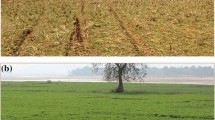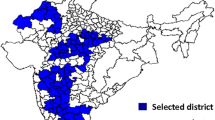Abstract
Haryana has emerged as an important state for Rice & Wheat production in India contributing significantly in the central pool. Mechanized combine harvesting technologies, which have become common in Rice Wheat System (RWS) in India, leave behind large quantities of straw in the field for open burning of residue. Besides causing pollution, the burning kills the useful micro flora of the soil causing soil degradation. There is no field survey (Girdawari) data available with the Government for the areas where stubble burning is taking place. The present paper describes the methodology and results of wheat and rice residue burning areas for three districts of Haryana namely Kaithal, Kurukshetra and Karnal for the year 2010 using complete enumeration approach of multi-date IRS-P6 AWiFS and LISS-III data. In season ground truth was collected using hand held GPS and used to identify area of burnt wheat/rice residues, associated crops and land features. After geo-referencing the satellite images, district images were masked-out and multi-date image data stacks were created. Normalized Difference Vegetation Index (NDVI) of each date was generated and used at the time of classification along with other spectral bands. The non-agricultural classes in the image included: forest, wasteland, water bodies, urban/settlement and permanent vegetation etc. The vector of these non-agriculture classes were extracted from the land use, imported and mask was generated. During the classification non-agriculture area was excluded by using mask of these classes. From this the agricultural area could be separated out. The area was estimated by computing pixels under the classified image mask. In season multi-date AWiFS data along with available single-date LISS-III data between third week of April to last week of May are found to be useful for estimation of wheat residue burning areas estimation. The data between second week of October to last week of November is useful for estimation of rice residue burning areas estimation at district level.







Similar content being viewed by others
References
Badarinath, K.V.S., Kiran Chand, T.R., & Krishna Prasad V. (2006). Agriculture crop residue burning in ht Indo-Gangetic Plains – A study using IRS-P6 AWiFS satellite data. Current Science, Vol. 91, No.8, 1085–1089 pp.
Dadhwal, V. K., & Parihar, J. S. (1985). Estimation of 1983–84 wheat acreage of Karnal district (Haryana) using Landsat MSS digital data. Scientific Note: IRS –UP/SAC/CPF/SN/09/85.
Dadhwal, V. K., Singh, R. P., Dutta, S., & Parihar, J. S. (2002). Remote sensing based crop inventory: a review of Indian experience. Tropical Ecology, 43(1), 107–122.
Gupta, P. K., Sahai, S., Singh, N., Dixit, C. K., Singh, D. P., Sharma, C., et al. (2004). Residue burning in rice-wheat cropping system: Causes and implications. Current Science, 87(12), 25.
Hooda, R. S., Yadav, Manoj., Sharma, M. P., & Prawasi, R. (2008). Estimation of summer paddy in Haryana (India) using high resolution satellite data. Proceedings. of International Workshop on Earth Observation & Remote Sensing Applications, China, 2008, (1-4244-2394-1/08/$20.00©2008IEEE).
Kalubarme, M. H., & Vyas, S. P. (1990). Remote sensing based rice acreage estimation in Midnapore district (West Bengal). Status Report on CAPE, RSAM/SAC/CAPE/SR/25/90, 178–188 pp.
Kalubarme, M. H., Sharma, A., Sood, R. K., Thapa, R., Deol, S. S., Negi, K. et al. (2004). Wheat production forecast in Himachal Pradesh. Scientific Note: RSAM/SAC/CAPE-II/SN/93/2004.
Ladha, J. K., Fischer, K. S., Hossain, M., Hobbs, P. R. & Hardy, B. (2000). Improving the productivity and sustainability of rice–wheat systems of the Indo-Gangetic plains: A synthesis of NARS–IRRI partnership research. IRRI Discussion Paper Ser. 40, IRRI, Los Banos, Philippines, 2000.
Maurya, A. K. (2011). Estimation of acreage & crop production through remote sensing & GIS technique. Proceedings of Geospatial World Forum, Hyderabad India, 1–14 pp.
Panigrahy, R. K., Ray, S. S., & Panigrahy, S. (2004). Utility of SWIR band for crop discrimination & classification using single date and Multidate IRS-P6 AWiFS data. Scientific Report: SAC/RESIPA/SR-02.
Panigrahy, S., Hooda, R. S., Ray, S. S., Yadav, M., Manjunath, K. R., Sharma, M. P. et al. (2008). Cropping system analysis using remote sensing & GIS: Haryana state. Technical Report: EOAM/SAC/CS/SN/02/2008.
Saroha, G. P., Yadav, Manoj., Sharma, M. P. & Singh, Ajeet. (1999). Sugarcane acreage estimation and monitoring using remote sensing and GIS techniques. Technical Report: HARSAC/TR/13/1999.
Sharma, S. A., Bhatt, H. P., Ajai, & Nanavaty, S. (1991). Rapeseed Mustard acreage estimation using IRS LISS-II data. Photonirvachak, 19, 59–65.
Singh, G., Kant, Y., & Dadhwal, V. K. (2009). Remote sensing of crop residue burning in Punjab (India): a study on burned area estimation using mulyi-sensor approach. Geocarto International, 24(4), 273–292.
Singh, R. B., Ray, S. S., Bal, S. K., Sekhon, B. S., Gill, G. S., & Panigrahy, S. (2013). Crop residue discrimination using ground-based hyperspectral data. Journal of the Indian Society of Remote Sensing, 41(2), 301–308.
State Statistical Abstract of Haryana (2013). Published by Department of Economic & Statistical Analysis, Govt. of Haryana, 840 pp.
Verma, U., Dabas, D. S., Hooda, R. S., Yadav, M., Grewal, M. S., Sharma, M. P., et al. (2011). Remote sensing based wheat acreage and spectral-trendagrometeorological Yield Forecasting : Factor Analysis Approach. Statistics and Applications, 9(1&2), 1–13.
Acknowledgments
Authors are thankful to Department of Agriculture, Govt. of Haryana for taking keen interest and providing financial assistance for providing financial assistance for the project and extending field support.
Author information
Authors and Affiliations
Corresponding author
About this article
Cite this article
Yadav, M., Sharma, M.P., Prawasi, R. et al. Estimation of Wheat/Rice Residue Burning Areas in Major Districts of Haryana, India, Using Remote Sensing Data. J Indian Soc Remote Sens 42, 343–352 (2014). https://doi.org/10.1007/s12524-013-0330-z
Received:
Accepted:
Published:
Issue Date:
DOI: https://doi.org/10.1007/s12524-013-0330-z




